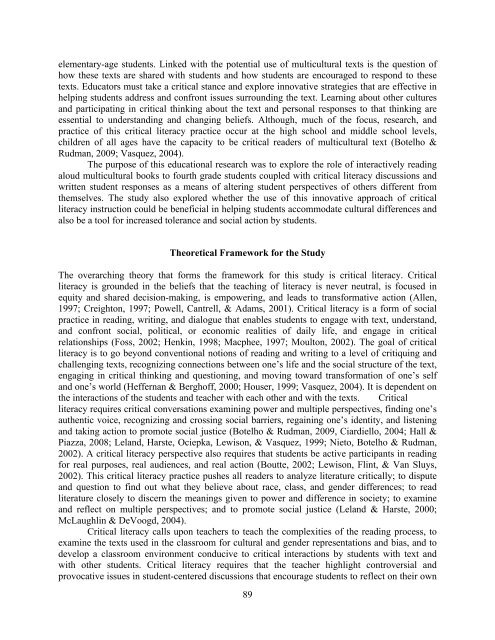Journal of Research in Innovative Teaching - National University
Journal of Research in Innovative Teaching - National University
Journal of Research in Innovative Teaching - National University
You also want an ePaper? Increase the reach of your titles
YUMPU automatically turns print PDFs into web optimized ePapers that Google loves.
elementary-age students. L<strong>in</strong>ked with the potential use <strong>of</strong> multicultural texts is the question <strong>of</strong><br />
how these texts are shared with students and how students are encouraged to respond to these<br />
texts. Educators must take a critical stance and explore <strong>in</strong>novative strategies that are effective <strong>in</strong><br />
help<strong>in</strong>g students address and confront issues surround<strong>in</strong>g the text. Learn<strong>in</strong>g about other cultures<br />
and participat<strong>in</strong>g <strong>in</strong> critical th<strong>in</strong>k<strong>in</strong>g about the text and personal responses to that th<strong>in</strong>k<strong>in</strong>g are<br />
essential to understand<strong>in</strong>g and chang<strong>in</strong>g beliefs. Although, much <strong>of</strong> the focus, research, and<br />
practice <strong>of</strong> this critical literacy practice occur at the high school and middle school levels,<br />
children <strong>of</strong> all ages have the capacity to be critical readers <strong>of</strong> multicultural text (Botelho &<br />
Rudman, 2009; Vasquez, 2004).<br />
The purpose <strong>of</strong> this educational research was to explore the role <strong>of</strong> <strong>in</strong>teractively read<strong>in</strong>g<br />
aloud multicultural books to fourth grade students coupled with critical literacy discussions and<br />
written student responses as a means <strong>of</strong> alter<strong>in</strong>g student perspectives <strong>of</strong> others different from<br />
themselves. The study also explored whether the use <strong>of</strong> this <strong>in</strong>novative approach <strong>of</strong> critical<br />
literacy <strong>in</strong>struction could be beneficial <strong>in</strong> help<strong>in</strong>g students accommodate cultural differences and<br />
also be a tool for <strong>in</strong>creased tolerance and social action by students.<br />
Theoretical Framework for the Study<br />
The overarch<strong>in</strong>g theory that forms the framework for this study is critical literacy. Critical<br />
literacy is grounded <strong>in</strong> the beliefs that the teach<strong>in</strong>g <strong>of</strong> literacy is never neutral, is focused <strong>in</strong><br />
equity and shared decision-mak<strong>in</strong>g, is empower<strong>in</strong>g, and leads to transformative action (Allen,<br />
1997; Creighton, 1997; Powell, Cantrell, & Adams, 2001). Critical literacy is a form <strong>of</strong> social<br />
practice <strong>in</strong> read<strong>in</strong>g, writ<strong>in</strong>g, and dialogue that enables students to engage with text, understand,<br />
and confront social, political, or economic realities <strong>of</strong> daily life, and engage <strong>in</strong> critical<br />
relationships (Foss, 2002; Henk<strong>in</strong>, 1998; Macphee, 1997; Moulton, 2002). The goal <strong>of</strong> critical<br />
literacy is to go beyond conventional notions <strong>of</strong> read<strong>in</strong>g and writ<strong>in</strong>g to a level <strong>of</strong> critiqu<strong>in</strong>g and<br />
challeng<strong>in</strong>g texts, recogniz<strong>in</strong>g connections between one’s life and the social structure <strong>of</strong> the text,<br />
engag<strong>in</strong>g <strong>in</strong> critical th<strong>in</strong>k<strong>in</strong>g and question<strong>in</strong>g, and mov<strong>in</strong>g toward transformation <strong>of</strong> one’s self<br />
and one’s world (Heffernan & Bergh<strong>of</strong>f, 2000; Houser, 1999; Vasquez, 2004). It is dependent on<br />
the <strong>in</strong>teractions <strong>of</strong> the students and teacher with each other and with the texts. Critical<br />
literacy requires critical conversations exam<strong>in</strong><strong>in</strong>g power and multiple perspectives, f<strong>in</strong>d<strong>in</strong>g one’s<br />
authentic voice, recogniz<strong>in</strong>g and cross<strong>in</strong>g social barriers, rega<strong>in</strong><strong>in</strong>g one’s identity, and listen<strong>in</strong>g<br />
and tak<strong>in</strong>g action to promote social justice (Botelho & Rudman, 2009, Ciardiello, 2004; Hall &<br />
Piazza, 2008; Leland, Harste, Ociepka, Lewison, & Vasquez, 1999; Nieto, Botelho & Rudman,<br />
2002). A critical literacy perspective also requires that students be active participants <strong>in</strong> read<strong>in</strong>g<br />
for real purposes, real audiences, and real action (Boutte, 2002; Lewison, Fl<strong>in</strong>t, & Van Sluys,<br />
2002). This critical literacy practice pushes all readers to analyze literature critically; to dispute<br />
and question to f<strong>in</strong>d out what they believe about race, class, and gender differences; to read<br />
literature closely to discern the mean<strong>in</strong>gs given to power and difference <strong>in</strong> society; to exam<strong>in</strong>e<br />
and reflect on multiple perspectives; and to promote social justice (Leland & Harste, 2000;<br />
McLaughl<strong>in</strong> & DeVoogd, 2004).<br />
Critical literacy calls upon teachers to teach the complexities <strong>of</strong> the read<strong>in</strong>g process, to<br />
exam<strong>in</strong>e the texts used <strong>in</strong> the classroom for cultural and gender representations and bias, and to<br />
develop a classroom environment conducive to critical <strong>in</strong>teractions by students with text and<br />
with other students. Critical literacy requires that the teacher highlight controversial and<br />
provocative issues <strong>in</strong> student-centered discussions that encourage students to reflect on their own<br />
89

















